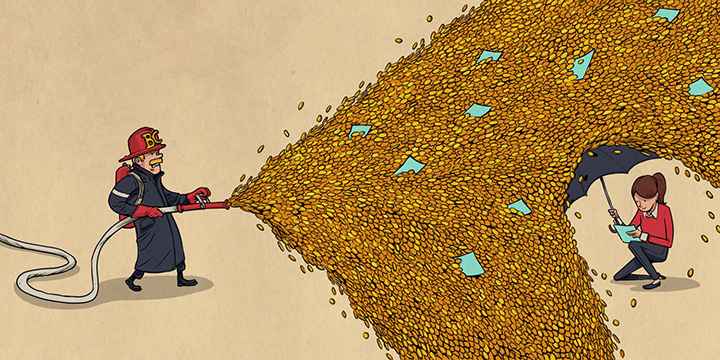The 2020 stock market year has been extremely atypical, but without doubt something that characterises it is the monetary policies implemented. The economic crisis triggered by the coronavirus pandemic has prompted coordinated intervention by central banks. It can be said that central bank policies have been the tool of choice since the 2008 crisis, but we have never seen such disproportionate injections of liquidity and these unprecedented levels of asset purchase programmes.
The central banks’ mandate par excellence is price stability, with an inflation target of close to 2%. Maintaining a certain level of inflation is not really an end in itself, but this threshold is considered to imply that the economy is operating with dynamic economic activity. The problem is that this price increase is intended to be achieved by increasing the money supply, i.e. the money in circulation, since the wide variety of asset purchases being made requires new money to be created.
It is important to understand that as central banks inject new money into the economy, with the aim of stimulating consumption, the supply of lendable funds expands and produces abnormally low interest rates for borrowers.
Between March and November, the money supply, measured in terms of M21, increased by 24 per cent. Surprisingly, the increase in the money supply in 2020 has exceeded any increase in the century and a half for which there are data.
Any rate increase has been completely off the table in the medium term and the balance sheets of these major central banks have skyrocketed in the last year. On 30 November the on-balance-sheet assets of the G4 central banks, i.e. the Federal Reserve, the European Central Bank, the Bank of Japan and the Bank of England, represented 54.3% of their countries’ total gross domestic product, compared with 36% at the end of 2019 and around 10% in 2008.

This unprecedented coordinated action has helped contain global bond yields, so much so that we have been living in a universe of negative returns for years, particularly in the euro area. In fact, the amount of bonds with below-zero yields at the end of 2020 has risen to over $18 trillion, which technically means that it pays to lend money. The world is upside down!
Buying an asset just because it is backed by a central bank purchase is not a value search at all, nor is it a secure asset.
This situation, among other things, facilitates indebtedness. Moreover, global debt increased at an unusual rate in the first nine months of the year when governments and companies embarked on a “debt tsunami” in the face of the coronavirus crisis, with it being expected to exceed 365 percent of the world’s gross domestic product.
In the case of the stock market, the main problem linked to credit expansion is the misallocation of resources driven by an artificially-low interest rate. Why is that? Strictly speaking, share prices indicate the price willing to be paid for partial ownership of companies. With a stable money supply, stock market gains would indeed reveal productivity and higher levels of savings and would be indicative of economic growth, but newly-created money increases these prices without real savings, favouring investors who also boost their stock market consumption and investment at the expense of increased indebtedness, thus pushing up the stock market.
Furthermore, to the extent that the stock market reflects this artificial growth, and it certainly has, it cannot serve as an accurate metric of economic health, as it encourages illusory valuations whose prices have been driven up by factors that are entirely external to the prospects of their businesses.
Also, low interest rates being maintained for a long time creates so-called zombie companies. These are companies where the costs of debt are greater than the profits they generate. Businesses that would otherwise not get funding are financed at a very low cost. Capital flows are being directed to unproductive enterprises, helping hundreds of struggling businesses gain virtually unlimited access to credit markets and thus depressing employment and growth in the years ahead.
A decade of low interest rates had already maintained a growing number of companies that could borrow cheaply and carry on with operating profits that failed to cover the interest needed to repay their loans. Now, the enormous debt issuance that triggered the depths of the COVID-19 crisis has accelerated that trend, forming a new generation of these so-called corporate zombies.

In the face of this clear misallocation of resources driven by an artificially-low interest rate, our investment decisions need to be analysed in depth more than ever.
At Cobas AM we believe that the best coverage in this situation is to own the assets, and invest in real assets, such as stocks. It is essential to maintain clear investment ideas that are rigorously-founded in well-managed companies with sound business models, low debt and entry barriers that provide long-term visibility, backed by good fundamentals, as experience shows that these are the best option to look after our savings.
Did you find this useful?
- |







